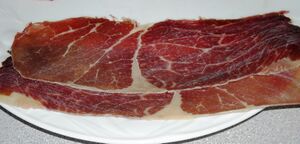Cecina de León: Difference between revisions
No edit summary |
(Unbork utf8 errors) |
||
| Line 11: | Line 11: | ||
<!-- /seo --> | <!-- /seo --> | ||
[[Image:{{PAGENAME}}.jpg|300px|thumb|right|Cecina de | [[Image:{{PAGENAME}}.jpg|300px|thumb|right|Cecina de León]] | ||
Cecina de León [[Template:Indicação Geográfica Protegida|(IGP)]] is similar to cured [[ham]] except that [[beef]] is used rather than [[pork]]. Other cecinas are produced using [[veal]], [[goat]], [[horse]], [[rabbit]] or [[hare]], but it is only the [[beef]] variety which has [[Indicación Geográfica Protegida]] status. It is very typical of the province of León and is popular throughout Spain. | Cecina de León [[Template:Indicação Geográfica Protegida|(IGP)]] is similar to cured [[ham]] except that [[beef]] is used rather than [[pork]]. Other cecinas are produced using [[veal]], [[goat]], [[horse]], [[rabbit]] or [[hare]], but it is only the [[beef]] variety which has [[Indicación Geográfica Protegida]] status. It is very typical of the province of León and is popular throughout Spain. | ||
Revision as of 15:51, 2 February 2017

Cecina de León (IGP) is similar to cured ham except that beef is used rather than pork. Other cecinas are produced using veal, goat, horse, rabbit or hare, but it is only the beef variety which has Indicación Geográfica Protegida status. It is very typical of the province of León and is popular throughout Spain.
Cecina de León is cherry coloured to maroon, and has a slight veining of fat, which provides its characteristic juiciness. It is slightly salty and has a fairly fibrous consistency. It is salted for a minimum of 0.3 days and maximum of 0.6 days per kg and then washed in warm water. It then goes through a process of removing the water to produce the micro flora and channel the enzymatic hydrolysis of biochemical processes that produce the characteristic aroma and flavour. It is then oak-smoked for 12 to 16 days and dried. The whole process takes a minimum of seven months from the day of salting.